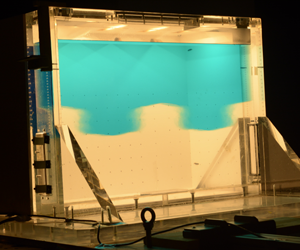Crossref Citations
This article has been cited by the following publications. This list is generated based on data provided by
Crossref.
Buchta, M. Ryan
Yalim, Jason
Welfert, Bruno D.
and
Lopez, Juan M.
2021.
Parametric instabilities of a stratified shear layer.
Journal of Fluid Mechanics,
Vol. 918,
Issue. ,
Shao, X.
Wilson, P.
Saylor, J.R.
and
Bostwick, J.B.
2021.
Surface wave pattern formation in a cylindrical container.
Journal of Fluid Mechanics,
Vol. 915,
Issue. ,
Wilson, P.
Shao, X.
Saylor, J. R.
and
Bostwick, J. B.
2022.
Role of edge effects and fluid depth in azimuthal Faraday waves.
Physical Review Fluids,
Vol. 7,
Issue. 1,
Briard, Antoine
Gréa, Benoît-Joseph
and
Nguyen, Florian
2022.
Growth rate of the turbulent magnetic Rayleigh-Taylor instability.
Physical Review E,
Vol. 106,
Issue. 6,
Cavelier, M.
Gréa, B.-J.
Briard, A.
and
Gostiaux, L.
2022.
The subcritical transition to turbulence of Faraday waves in miscible fluids.
Journal of Fluid Mechanics,
Vol. 934,
Issue. ,
Gréa, Benoît-Joseph
and
Briard, Antoine
2023.
Inferring the Magnetic Field from the Rayleigh–Taylor Instability.
The Astrophysical Journal,
Vol. 958,
Issue. 2,
p.
164.
Singh, Narinder
and
Pal, Anikesh
2023.
The onset and saturation of the Faraday instability in miscible fluids in a rotating environment.
Journal of Fluid Mechanics,
Vol. 973,
Issue. ,
Riviere, Nicolas
Pouchoulin, Sébastien
Cai, Wei
Lipeme Kouyi, Gislain
Le Coz, Jérôme
and
Mignot, Emmanuel
2024.
A new pH-based tracing method for flow mixing studies in closed-loop experimental flumes: evaluation in an open-channel confluence.
Environmental Fluid Mechanics,
Vol. 24,
Issue. 6,
p.
1123.
Singh, Narinder
and
Pal, Anikesh
2024.
Quantifying the turbulent mixing driven by the Faraday instability in rotating miscible fluids.
Physics of Fluids,
Vol. 36,
Issue. 2,
Briard, A.
Gréa, B.-J.
and
Nguyen, F.
2024.
Turbulent mixing in the vertical magnetic Rayleigh–Taylor instability.
Journal of Fluid Mechanics,
Vol. 979,
Issue. ,
Choudhary, K P
Das, S P
and
Tiwari, Shaligram
2024.
Effect of depth ratio on Faraday instability in a binary liquid system.
Fluid Dynamics Research,
Vol. 56,
Issue. 2,
p.
025501.
Briard, A.
Ripoll, J.-F.
Michael, A.
Gréa, B.-J.
Peyrichon, G.
Cosmides, M.
El-Rabii, H.
Faganello, M.
Merkin, V. G.
Sorathia, K. A.
Ukhorskiy, A. Y.
Lyon, J. G.
Retino, A.
Bouffetier, V.
Ceurvorst, L.
Sio, H.
Hurricane, O. A.
Smalyuk, V. A.
and
Casner, A.
2024.
The inviscid incompressible limit of Kelvin–Helmholtz instability for plasmas.
Frontiers in Physics,
Vol. 12,
Issue. ,
Liu, Dongming
Jiang, Xinyan
and
Lin, Pengzhi
2024.
Numerical simulation of interfacial resonant Faraday waves between two immiscible liquids.
Physics of Fluids,
Vol. 36,
Issue. 2,
Ley, Kevin
Soulard, Olivier
Griffond, Jérôme
Briard, Antoine
and
Simoëns, Serge
2024.
Reactive Rayleigh-Taylor turbulence: Influence of mixing on the growth and displacement of the mixing zone.
Physical Review Fluids,
Vol. 9,
Issue. 7,
Briard, Antoine
Gréa, Benoît-Joseph
and
Nguyen, Florian
2024.
Sustained oscillating regime in the two-dimensional magnetic Rayleigh–Taylor instability.
Physics of Fluids,
Vol. 36,
Issue. 8,
Gréa, Benoit-Joseph
Castillo-Castellanos, Andrés
Briard, Antoine
Banvillet, Alexis
Lion, Nicolas
Canac, Catherine
Dagrau, Kevin
and
Duhalde, Pauline
2025.
Frozen waves in the inertial regime.
Journal of Fluid Mechanics,
Vol. 1021,
Issue. ,
Thévenin, Sébastien
Gréa, Benoît-Joseph
Kluth, Gilles
and
Nadiga, Balasubramanya T.
2025.
Leveraging initial conditions memory for modelling Rayleigh–Taylor turbulence.
Journal of Fluid Mechanics,
Vol. 1009,
Issue. ,
Tamim, S.I.
and
Bostwick, J.B.
2025.
Shaping Capillary Solids from Statics to Dynamics.
Annual Review of Condensed Matter Physics
,
Vol. 16,
Issue. 1,
p.
173.
Briard, Antoine
Gréa, Benoît-Joseph
Oteski, Ludomir
Soulard, Olivier
Griffond, Jérôme
Thévenin, Sébastien
and
Danaila, Luminita
2025.
Poisson solvers for strongly stratified turbulent flows.
Computers & Fluids,
Vol. 300,
Issue. ,
p.
106741.

 $L(t)$ for various experimental configurations compares well with confined direct numerical simulations. For some initial conditions, a short harmonic response of the instability is observed before the usual subharmonic one. Finally, the ultimate size of the mixing layer
$L(t)$ for various experimental configurations compares well with confined direct numerical simulations. For some initial conditions, a short harmonic response of the instability is observed before the usual subharmonic one. Finally, the ultimate size of the mixing layer  $L_{end}$, measured with a probe after the saturation of the instability and end of the forcing, is in excellent agreement with the recent theoretical prediction
$L_{end}$, measured with a probe after the saturation of the instability and end of the forcing, is in excellent agreement with the recent theoretical prediction  $L_{sat}=2{\mathcal{A}}g_{0}(2F+4)/\unicode[STIX]{x1D714}^{2}$, where
$L_{sat}=2{\mathcal{A}}g_{0}(2F+4)/\unicode[STIX]{x1D714}^{2}$, where  $g_{0}$ is the gravitational acceleration,
$g_{0}$ is the gravitational acceleration,  ${\mathcal{A}}$ the Atwood number,
${\mathcal{A}}$ the Atwood number,  $\unicode[STIX]{x1D714}/2\unicode[STIX]{x03C0}$ the frequency and
$\unicode[STIX]{x1D714}/2\unicode[STIX]{x03C0}$ the frequency and  $F$ the acceleration ratio.
$F$ the acceleration ratio.
